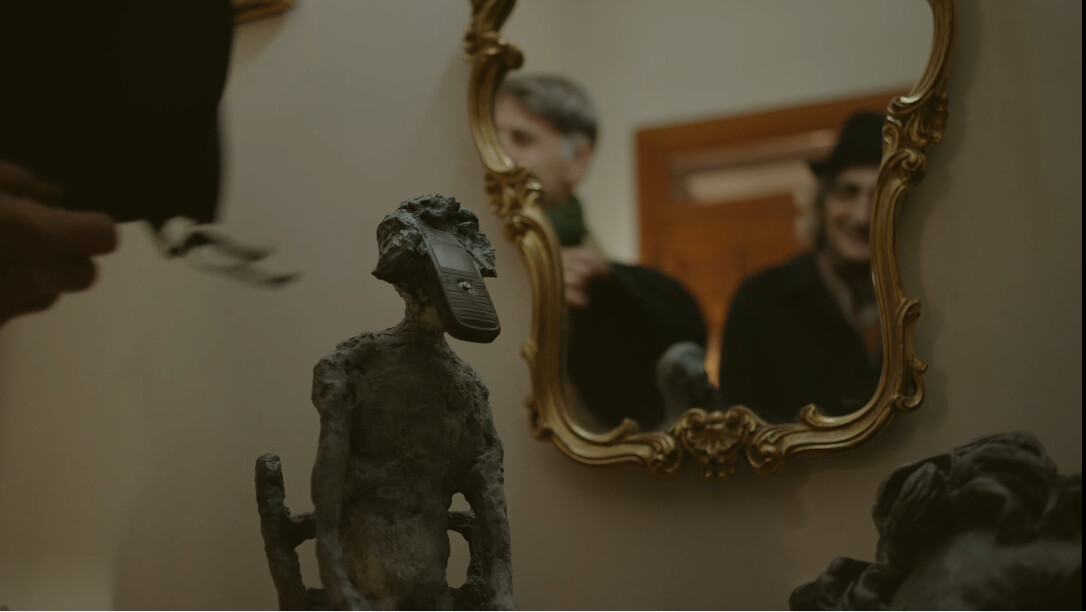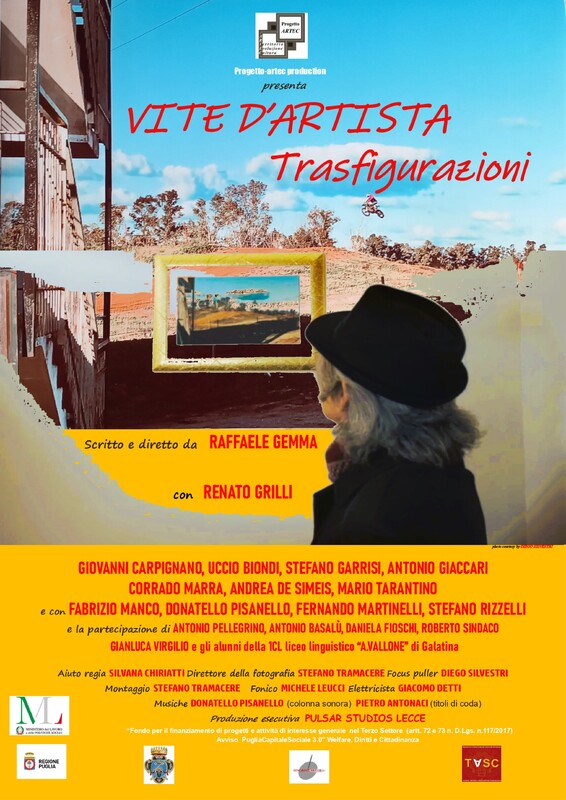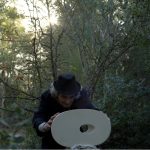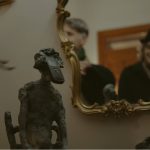
SHORT FILM “ARTISTS' LIVES – TRANSFIGURATIONS”
First work.
Written and directed by Raffaele Gemma, it closes Syncronicart-6, the sixth edition of the Contemporary Art Biennale in Salento. Strictly speaking, the short film could be defined as a docu-film, since there is a thematic thread focused on contemporary art and, subtly, on the critical-artist relationship, the most genuine one, which is established during what are usually called “studio-visit.”
The role of the protagonist is entrusted to Renato Grilli, an experienced film and theater actor. He plays a critic who successively meets artists already known during his life, as he himself announces at the beginning, in recent or more distant times.
Rather than didactically reviewing the artistic production of each of them, the protagonist uses a single significant work as a pretext to bring out details that reveal the attitude of each artist and concern more intimate aspects of their lives, of which the critic-visitor is evidently aware. All the actors practically play themselves in a non-documentary way but based on a structured screenplay, but this particularity is not only valid for the actor Grilli, to whom the assignment of the role is necessarily obligatory for reasons to be discovered in the finale. In a certain sense, it also concerns other characters who appear in a non-artistic role.
Being an autobiographical film, the director Raffaele Gemma, through Grilli, navigates various situations concerning the different artists amidst highly evocative scenographic-environmental atmospheres and “amarcord”-like revivals of renewed encounters with people known in the past, between dreamlike and fantastic reconstructions, often rendered with the device of flashbacks and more current socio-anthropological investigations. These aspects are finalized by the director-screenwriter towards a subtle plot, which begins with the memory evoked by a photograph of his that reminds him of the place where he was over fifty years earlier, a corner of the cloister of the Basilica of Santa Caterina d’Alessandria in Galatina, and concludes with the actor's memory, thanks to another photo, of a particular biographical episode of his artistic life that inexorably connects him to the screenplay. It is a photo that portrays him in the role of Kafka's double on the set of F. Fellini's film “Ginger and Fred.” These episodes, and the photos that recall them, concern real events; the fiction lies in the recovery of memories that takes place at the end in the actor, who thus, from the “splitting” of personality typical of those who play a role, seems to slowly return to himself, with the aid of a photo, in an atmosphere that is also “Kafkaesque.”
The interpreter himself therefore appears at the end also caught by a “transfiguration,” while during the film the “transfigurations” are nothing more than “encroachments” concerning those artists who in some cases carry out, or have carried out in the past, work activities in completely different fields.
Also in the case of the director-screenwriter Gemma, it is, if we want, an “encroachment,” not so much from the point of view of content, which appears consistent with his personal ultra-decade-long critical experience in the field of contemporary art, but because the short film represents a “first” cinematographic work. In other cases, the transfigurations are mental elaborations in the guise of memories, flashbacks, dreamlike visions that recur in the protagonist's mind to create a mysterious atmosphere. At the end of the film, another phrase taken from Kafka's stories, spoken by the actor and adapted to photographs as objects, but which could be connected to the works of the artists in general, recreates that atmosphere of melancholy, nostalgia, and mystery that leads us to reflect further on existentialism and the transience of life.
Framing the scenes are the backgrounds of the original or resident cities of each artist, all in the greater Salento area: Galatina, Sogliano Cavour, Caprarica di Lecce, Martano, Sternatia, Ceglie Messapica, Palagianello. The production is also entirely from Salento, from the actors to the director, from the production to the executive production, from the crew to the music authors.
Music by Donatello Pisanello for the soundtrack, “Sciamani” taken from the homonymous performance by Art Lab, and “Metamorfosi,” which create pertinent and suggestive atmospheres, and by Pietro Antonaci for the end credits with “Lascio tutto” (I leave everything), also not accidental and emblematic. Progetto-artec production, Pulsar Studios Lecce for executive production, assistant director Silvana Chiriatti, director of photography Stefano Tramacere, focus puller Diego Silvestri, sound engineer Michele Leucci, electrician Giacomo Detti. The short film is the final step of the Syncronicart-6 project (sixth edition of the Biennale of Contemporary Art in Salento), winner of the Puglia capitale sociale 3.0 call for proposals, Puglia Region, Department of Welfare, Rights and Citizenship, Ministry of Labor and Social Policies. Other sponsors include the City of Galatina, Department of Culture, and TASC (Territory and Visual Arts Didactic Laboratory of Contemporary Art History of Unisalento), directed by Prof. Massimo Guastella.
Renato Grilli, Uccio Biondi, Giovanni Carpignano, Andrea De Simeis, Antonio Giaccari, Mario Tarantino, Stefano Giovanni Garrisi, Gianluca Virgilio






